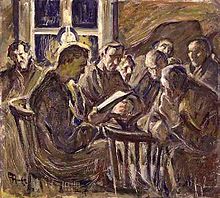


| Part of a series on |
| Liberalism |
|---|
 |
Freedom of peaceful assembly, sometimes used interchangeably with the freedom of association, is the individual right or ability of people to come together and collectively express, promote, pursue, and defend their collective or shared ideas.[2] The right to freedom of association is recognized as a human right, a political right and a civil liberty.
The terms freedom of assembly and freedom of association may be used to distinguish between the freedom to assemble in public places and the freedom to join an association. Freedom of assembly is often used in the context of the right to protest, while freedom of association is used in the context of labor rights. The Constitution of the United States is interpreted to mean both the freedom to assemble and the freedom to join an association.[3]
- ^ California Vehicle Code § 21950(b): "No pedestrian may unnecessarily stop or delay traffic while in a marked or unmarked crosswalk."
- ^ Jeremy McBride, Freedom of Association, in The Essentials of... Human Rights, Hodder Arnold, London, 2005, pp. 18–20
- ^ See: NAACP v. Claiborne Hardware Co., 458 U.S. 898 (1982); Healey v. James, 408 U.S. 169 (1972); Brotherhood of Railroad Trainmen v. Virginia, 377 U.S. 1 (1964); United Mine Workers v. Illinois State Bar Assn., 389 U.S. 217 (1967).
